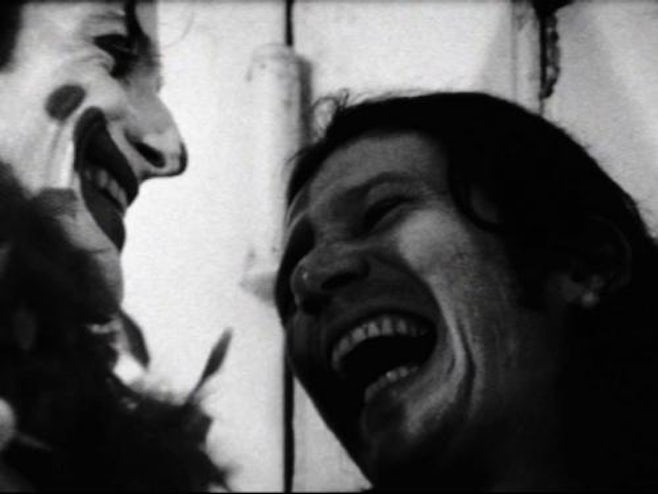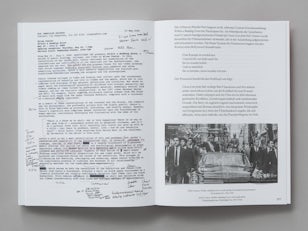
When I reviewed Ellen Cantor in the journal Texte zur Kunst in late 2016, Donald Trump had not yet been elected president of the USA, and Jair Bolsonaro was still unknown outside of Brazil. 01
Two and a half years on, (proto-)fascistic autocrats are no longer a thing of the past on the American continent, increasingly finding their way (back) into the hearts of liberal-democratic societies.
No artistic work that I have seen in recent years presented this (at the time) still unconsidered possibility as drastically and with as much foresight as that of the US-American artist Ellen Cantor, who died in 2013 at the age of 51. This is true above all of her Super 8mm film Pinochet Porn, which remained incomplete in her lifetime and was only finished in the years following her untimely death, brought to completion by those friends and colleagues of the artist who had also been involved in the project, acting as the film’s co-producers and performers. Viewing it in 2016, the film most immediately brought to mind that dark period of Latin American dictatorships whose overthrow in the late 1980s was supposed to make the Global South a symbol of hope for the left in the Global North. Writing now, just a few years later, it is clear Cantor’s work carries more disturbing questions for the present.
At the centre of the story are five children who have grown up during the 17-year reign of Augusto Pinochet, which began on 11 September 1973 with a coup supported by the US administration of the time: according to the US-American political scientist Wendy Brown, the coup marked the beginning of the ‘experiment’ of neoliberalism imposed on the country by Pinochet and the group of Chilean economists known as the ‘Chicago Boys’. 02 When Cantor’s work was exhibited at Künstlerhaus Stuttgart in 2016, presented with the greatest curatorial care by Jamie Stevens and Fatima Hellberg, Pinochet Porn was the centrepiece, accompanied by further filmic and painted works and the 80-part drawing and collage series Circus Lives from Hell (2004). 03 The accompanying publication, Ellen Cantor: A history of the world as it has become known to me – edited by Hellberg and Stevens with Lia Gangitano, a close collaborator and friend of Cantor – presents an image-text montage that closely mirrors the work itself and congenially captures Cantor’s subtle and playful interweaving of authorial voice and fictional narration. 04
The translation of the artist’s visual language – simultaneously experimental and formally elaborate, lightly drafted and diagnostically condensed – into the format of the print publication represents, in my eyes, a highly convincing example of the documentation of an artistic work that seemingly had its problems with overly distinct genres, combining as it does the variously sized sheets of the drawings and collages with varying media formats. Correspondingly, it’s barely possible for the reader to distinguish between autobiographical, documentary and fictional levels of representation. Clara López Menéndez’s collection of ‘fragments’, compiled from Cantor’s archive and combined with passages of text by ‘friends, collaborators, muses’, 05 exemplifies the editorial decision to forgo any hierarchy of primary and secondary information, artwork and biography, analysis and description, text and metatext. This equally applies to the way in which the collages and drawings are given the central position in the book but are also combined with Cantor’s production notes and stills from Pinochet Porn. It’s also worth mentioning here the outstanding and in every respect congenial graphic design by Pedro Cid Proença, as well as the high print quality, which allow for a close viewing of the drawings and collages, presented by turns as extremely delicate and miniature, large and sketch-like or assembled in layers. The core of Cantor’s drawings and collages, which oscillate between schema and detail, lies the at the point of transition between the (masculine-coded) compositional principles of centring and verticality and those of diagonality, horizontality and circularity: her ‘handwriting’ borrows from children’s books and comics, with clowns, Barbies and other archetypal figures from fairy tales or cartoons implying a break in the work’s (auto)biographical aspect. The ‘short biographies’ of both the main and supporting actors in Cantor’s ‘circus of hell’ consequently appear always to be the expression of a socio-media imagination. The manner in which Cantor connects ‘world history’ to the topos of love, her central motif, can already be observed in her characterisation of the story’s first figure, Manuelo, whom she presents as a clown. His father is a Hungarian Jew and survivor of Auschwitz, a ‘wealthy industrialist’ in Santiago who ‘fathered two children with a seventeen-year-old girl’. While she ran off with a soldier, his ‘aged wife, heartbroken, had become addicted to alcohol and drugs’, forgiving her disloyal spouse but rejecting the children, who ended up staying on in the family’s ‘huge mansion’ with its ‘servants’: ‘He and his little sister could have ANYTHING. But they had no mother. No father. No love.’ 06

These few lines, and the drawing they accompany, speak of Cantor’s preference for ambivalent and broken figures who, trapped in infantile psyches and without any emotional stability, are barely capable of sublimating their libidos other than through serial marriage, relentless consumption and obsessive sex. Her metamorphic transformations of archetypes illustrate the way in which the work’s (quasi-)filmic narration is at all times driven by the possibilities for action by a character whose fate is already predetermined. And so Manuelo becomes an enlightened student of ‘Osha’, the ‘fucking guru’, played by Cerith Wyn Evans, who ‘[teaches] his disciples about free love with no jealousy’. 07 As such, Osha presents a hippyesque counterfigure to the monogamous system of marriage and family and provides Manuelo with the authority figure denied to him in his childhood. A few pages and drawings later, we learn that Manuelo will nonetheless physically attack his girlfriend – a woman in possession of the perfect amount of beauty, who presumably earns her living with sex and whom he desperately wants to save – out of jealousy, even if he didn’t really love her. Another few pages on, one finds an altered version of an emblem that opens Cantor’s series: a sailboat, which appears on circular pieces of cut-out paper, at times as a drawing and at others reproduced as a stencil. Subtitled ‘Death Trip’ on the first sheet in the series, it later reappears with a (painterly) smudge in its pencil work; it’s possible that, within the romantically loaded motif of the sailboat, the sense of melancholy we associate with both the paintings of Caspar David Friedrich and the mysterious disappearance of Bas Jan Ader (the Dutch conceptual artist whose interest in allegorically staging his own (auto)biographical persona mirrored Cantor’s own) is literalised; here, too, one is struck by ambiguous attributes of the sort that Cantor’s figures experience as an entanglement of love, sex and death drives. The metaphoric crossover between her ‘allegories’ correspondingly gives rise to an associative reading: who wouldn’t recognise these five children as hybrids of Marcuse’s Freudo-Marxism, the workers of Warhol’s Factory and the members of Otto Mühl’s commune (a reference eerily reminiscent of the Colonia Dignidad in the context of Pinochet Porn)?
The proximity between fascist dictatorships and sexual exploitation, as indicated by the film’s title, operates on that axis of oppressively heteronormative subjectivisation that has time and again been staked out by such queer authors, artists and filmmakers as Kathy Acker, Bette Gordon, Rainer Werner Fassbinder, Jean Genet, Hélio Oiticica, Pier Paolo Pasolini, Yvonne Rainer, Jack Smith and many others. An understanding of the dialectics of (patriarchal) power and (sexual) liberation was also a central object of the filmic and artistic appropriation of the psycho- and melodrama in the 1970s, ’80s and ’90s, echoes of which can be perceived in Cantor’s evidently schizoanalytically informed dramaturgy. And so it is at the interface of social modes of experience, the imaginary of the modern media society and therapeutic (self-) experimentation that possibilities for ‘other’ (bourgeois, patriarchal and heteronormative) forms of subjectivisation are sought. When a classically voyeuristic glimpse behind the scenes is offered, it seemingly serves to reinterpret hetero-pornographic stereotypes as queer-pornographic desire – as for example in the scene in which Pinochet demonstrates his power through the sexual subjectification of his housemaid, played by Cantor, and in this way degrades his wife. This display of the dictator’s childish, infantile and totalitarian nature is reflected in the staging of each of the story’s characters, bringing attention to the question of collectively internalised fascism. The drastic manner in which Cantor uses differentiated repetition to break apart the primal scene of a structure of power and subjugation, complicit in Foucault’s description, gives the impression that Pinochet Porn represents an attempt to sound out the ability of queer bodily performance to metamorphically transform existing (gender) politics.

It is in the double figure of the sisters Paloma and Pipa, ‘identical’ despite the one-year difference in their ages, that such instances of transformation are most explicit: in the book, the sequence outlining their history follows that of two friends, both of whom share the name Ellen. One is the story’s first-person narrator and the other her neighbour, who is a few months older. The friends feel like twins because of their shared name. With this, Cantor’s narrative style repeatedly orientates itself around the triad of father-mother-child, while undermining it through a doubling of the identical and the different. While the twin sisters, played by Gangitano, move between consumerist child-women, loving mothers and hip It girls à la Edie Sedgwick, Cantor herself appears staged as a series of cliched personality types – alongside that of the abused servant girl, as a sad clown and a glamorous underground queen. The way in which Pinochet Porn blends real political tragedies with a vision of bohemia that fluctuates between excess and collapse likewise indicates a proclivity for ‘postmodern’ hybrids of seemingly irreconcilable aesthetics: alongside the many recognisable rock and pop songs of the film’s soundtrack, it is the seemingly nostalgic folk songs of the singer and director Víctor Jara, murdered only days after Pinochet assumed power, that serve as a reminder – one entirely relevant to this particular moment – of the societal roots of fascist oppression and exploitation.
Combining photographs and film stills depicting, for example, a General Motors carnival parade and a military patrol on the streets of Santiago de Chile, the artist presents the oedipal familial structure as a systematic cornerstone of a societal order based upon expansive consumption, brutal subjugation and restrictive control – an order Cantor locates within the context of the Pinochet regime, whose establishment was directly related to the (economic) interests of the USA. Pinochet’s dictatorship was intended to put an abrupt end to Allende’s socialist awakening, and Cantor presented this as being still unprocessed history at the time she began working on her series. Seen from the perspective of a close female friend of the artist who had grown up in Chile, figures constructed through processes of mirroring, doubling and duplication prove themselves to be quasi-reflexive tools for the analysis of a social schizophrenia. The expressive register for this in Cantor’s film is akin to soap opera; its affect-laden pictorial language speaks, to my mind, of an interest in the potential of low-culture genres for emotional expression, of a piece with her appropriation of the techniques of psycho- and melodrama. These always revolve around the inescapable entanglement of the actors’ subjective inner perspectives with media-dominated emotional worlds.
In this context, the question posed at the film’s end is programmatic: ‘Is tragedy a choice?’ 8 The term tragedy describes a decision that is predestined by fate but must nonetheless be made time and again, and whose (deadly) consequences must be enacted. Within myths, fairy tales and other narrative models, it forms a narrative anchor that links the personal-autobiographical to the collective-historical. Significantly, the film’s actors play with the fiction that they are not just acting out their characters, but also operating at all times in ‘real’ roles; as such, this clearly joyous duplicity seems to influence the possibilities of their ‘own’ destinies as ‘real’ work. If Cantor is to be believed, this possibility lies in radical love, her work’s central motif. The film’s schizoanalytical construction correspondingly reveals itself as offering a view – simultaneously tender and merciless, and at no point presented as black and white – of the ‘fates’ of the five children, whose lives, loves and sufferings we experience as and in those aesthetic-existential media forms with and within which they are relayed. The publication brings all these layers into sharp focus: the editorial and graphic implementation of a collaboration formed on the basis of (long-held) friendships and/or (temporary) alliances turns out to be the enabling condition of a project whose poetic-affective intensity would be unthinkable without the obvious emotional investment of those involved – at one point in the book, the artist talks of ‘magical intuitive cooperation’ as the ‘most satisfying’ part of making the film, ‘especially as being an artist can often be extremely solitary.’ 9 And Cantor’s film is precisely that: an undertaking conceived of in opposition to the classic division of labour, with virtually all involved acting both in front of and behind the camera. As such, it is probably no coincidence that its variously shaded and contoured figures serve to produce affective resonances between socioanalytical construction as a form of performance and presentation as a form of reception; in this way, its serial sequences correspond to both the lateral principle of the sheets displayed in the exhibition’s vitrines and the consecutive principle of the medium of print.

Finally, the way in which the book documents Cantor’s film as the expression of a relentless communication with its actors, in correspondence with its presentation of the work itself, serves as an unmistakable reminder of the impossibility of a retrospective view: in their equal treatment of varying text formats (description, correspondence, diary entry, narration, essay etc.), the book’s editors and designers evoke the presence of a ‘talking writing’ that allows the work of the artist to be received not (only) as history, but as an experience of reading that is renewed with each consideration of the material, through (re)combinations of its non-linear elements.
Without question, the film’s splicing in of stills documenting Pinochet’s violent rise to power on 11 September 1973 also awakens memories of 9/11, a date that stands for increasing xenophobic nationalism and militaristic patriotism, for Islamophobic racism and sexist discrimination, and for growing paranoia and an unbridled mania for control. The way in which Cantor mixes drawings with her own childhood and those of others in fictitious biographies, pseudo-authenticated with documents of real political events, seems at all times to be led by the question of the possibilities for an emancipative transformation of a popularisation of reactionary affects currently dominated by the right. And so the transformation of Pinochet Porn’s players to sexualised ornaments of organless bodies at the film’s beginning could be understood as calling for a progressive relinking of subjects and affects. But the sense of collective happiness invoked by the film’s slacker-esque and immersive camerawork doesn’t last long: caught up in the intoxication of liberated sex, Manuelo receives a fateful letter reminding him of his responsibilities to his father’s brutal legacy. Tragedy contaminates all, including Ellen Cantor’s decision for a post-oedipal familialism that offers an example, relevant in every respect, of a consideration of subject relations whose difference lies in their privilege – a consideration every bit as aesthetic as it is political.
Translated from German by Ben Caton.
Footnotes
-
See ‘Überblendungverhältnisse: Sabeth Buchmann über Ellen Cantor im Künstlerhaus Stuttgart’, Texte Zur Kunst, no.104, December 2016, available at https://www.textezurkunst.de/104/104-ueberblendungsverhaeltnisse/
-
Wendy Brown: Die schleichende Revolution. Wie der Neoliberalismus die Demokratie zerstört, Frankfurt a.M.: Suhrkamp, 2015, p.19.
-
Cantor’s work has been also shown recently at CCA Wattis, San Francisco: ‘The Cinderalla Syndrome’, curated by Hellberg and Stevens, 8 February–13 April 2016 and in a series of concurrent exhibitions, public programs, and screenings featuring the work of Cantor later in 2016 in New York City, with exhibitions at Participant Inc., 80WSE, Maccarone and Foxy Production, and with public programmes hosted by Skowhegan and Electronic Arts Intermix. The world premiere of Cantor’s film Pinochet Porn(2008–2016) took place at The Museum of Modern Art in 2016.
-
Lia Gangitano, Fatima Hellberg and Jamie Stevens(ed.), Ellen Cantor: A history of the world as it has become known to me (exh. cat.), Berlin: Sternberg Press et al., 2018.
-
Lia Gangitano, Fatima Hellberg and Jamie Stevens(ed.), Ellen Cantor: A history of the world as it has become known to me (exh. cat.), Berlin: Sternberg Press et al., 2018.
-
See Clara López Menéndez, ‘In a few words we come to explain the infinite: Fragments of Pinochet Porn’, in ibid., pp.7–41, here p.8. The fact that Lia Gangitano is mentioned in Cantor’s notes as a source of ideas for the cinematic implementation of ‘Circus Lives from Hell’ is an indication of the networked nature of the production.
-
Ellen Cantor, ‘Circus Lives from Hell’, in Ellen Cantor, op. cit., p.52.
-
E. Cantor / C. L. Menéndez, ‘In a few words we come to explain the infinite’, in Ellen Cantor, op. cit., p.30, fn.5.
-
See the brochure accompanying the exhibition ‘Ellen Cantor’, Künstlerhaus Stuttgart, 2016.
